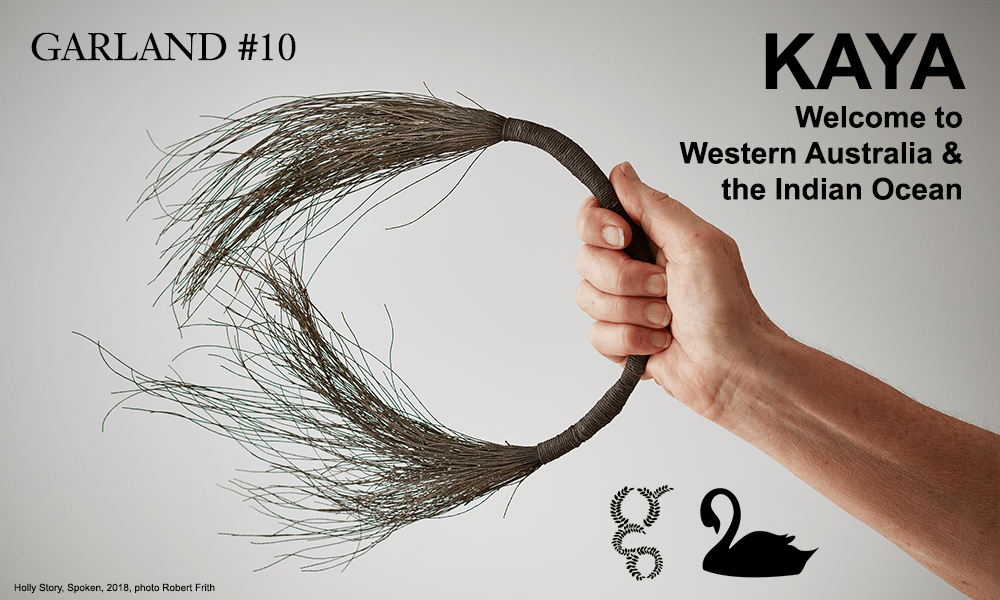KAYA – Western Australia and the Indian Ocean

“Menak unpinned his cloak and offered it to one of them. Kaya. Ngayn wardang didarak . . . Ngan kwel Wooral maadjit koonyart . . . He offered a greeting, some words of where he came from and how he was known. The younger of the Elders accepted Menak’s gift, and the two men each put their cloak across the other’s shoulders, pinning it at the throat.”
Kim Scott, That Deadman Dance, 2010, Macmillan Publishers Australia.
With this issue, we move from Moana Pacific to the Indian Ocean. While the Moana stories were about continuity of past and future, the Indian Ocean stories are more about encounters between different times and spaces. As told by Glenn Iseger-Pilkington, this can involve looking east into the Ngaanyatjarra land for an enduring sense of home. Other stories look West to the spread of Tamil cultures across the seas. The connecting concept is “kaya”, the Noongar word for “hello” and “yes”. This word recurs in Kim Scott’s That Deadman Dance when Noongar characters come across the newly arrived British. Today, it also appears as the title of his poem that features in the new Perth Stadium. The writers in this issue tell of objects that are exchanged between cultures through the western part of the Australian continent and across the ocean, including Indian, South African, Mauritian and Kuwaiti. “Kaya” is a statement of openness that enables these cultures to connect.
Special thanks to Nalda Searles, Jude van der Merwe, Julian Goddard, Mike Rees and Ric Spencer for help with this issue.
Table of contents
Quarterly essay
- Ngurra: Finding our way home Glenn Iseger-Pilkington
Along the west
- The Nullians Sharyn Egan
- From glass beads to smoke water: Investigating the vocabulary of loss and renewal in the landscapes of the Yilgarn Craton Gregory Pryor
- Sheoak voices Holly Story
- Purgatory on the Broome Peninsula: the art of Clare Peake Gemma Weston
- A silent conversation with Jimmy Poland Helena Bogucki
- Conjured from the ocean, hand-made from steel Gary Warner
- Sustainable housing for artists and creatives: A new cooperative model in Fremantle Koral Ward
Looking west
- Archipelagos of the decolonised mind: Two Indian Ocean exhibitions John Mateer
- Perth Mosque: A cultural structure strengthening collective identity Qassim Saad
- Looking in looking out: Yogic practice and public art in Western Australia Maggie Baxter
- Vahana: An Indian-Australian cross-cultural ceramic experience Bernard Kerr
- Her Journey and our empty cups: Fiona Gavino in Escolta Dayang Yraola
- Call Them Home Marziya Mohammedali
Looking east
- Full circle: Tjanpi, Polyglot and FORM’s Manguri Wiltja project Andrew Nicholls
- “Who’s Nalda?” The influence of Eileen Keys and Pantjiti Mary McLean Kevin Murray
- Wakuwal: Threads of reconciliation Peter Botsman
- Developing fabric designs at Ikuntji Artists Chrischona Schmidt
- Baluk Arts: Storied objects tied to Country Tallara Gray and Neil Aldum
- Alistair Rowe’s Chandni Chowk: One Altered Move Andrew Varano
Indian Ocean
- Where did all the flowers go? Tamil festivals in Mauritius Veemanda Curpen
- Batik and tenun as sustainable textiles in East Java Janet Teowarang
- Washed ashore: Art works from the Indian Ocean Gopika Nath
- They remember those who do not speak: Madhvi Subrahmanian’s recent ceramic works Nancy Adajania
- Material culture in Arabia: Bedouin women and the art of sadu weaving Laila Al-Hamad
- It begins with a pomegranate: Sirjan kilims Mahjabin Ilkhanipour
Cultures meet
- Smile for the embroidery: Abdul Abdullah and DGTMB Abdul Abdullah
- Accessing the heart of hand-stitch: Merging tradition and innovation on the Indian sub-continent Trish Bygott and Nathan Crotty
- Ankara print histories alive in the streets of Johannesburg Belinda Cook
- Making Retronesia: Modern Dutch architecture in Indonesia Tariq Khalil
Elsewhere
- Becoming visible: the Mojawharat jewellery project for migrants Vicky Tsaconas
- From the Top End down: An Adrienne Kneebone story Kevin Murray
- No touching – A curatorial reading of contemporary ceramics on Instagram Yasmin Masri
- The dark glow of the mirror in Santiago Carbonell’s mural, Mexico City Madelaine Kelly

